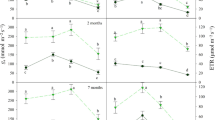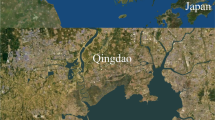Abstract
This study experimentally compares growth of four aquatic macrophytes species (Sparganium emersum Rehm., Hippuris vulgaris L., Groenlandia densa (L.) Fourr., Luronium natans (L.) Raf.) with different modes of winter persistence in a thermally buffered habitat. The question is whether the above-ground persistence of photosynthetic structures during winter can compensate for low growth rates of evergreens when they compete with fast growing, non-evergreen species. The experiment was carried out in experimental boxes installed in a former river channel fed by stenothermic ground-water. Species were planted pairwise in experimental boxes in autumn, monitoring was carried out in the following year: degree of evergreenness was evaluated through number of ramets present prior to the main growing season, competitive ability of species was assessed during the growing season through cover measurements at three dates. Degree of evergreenness varied considerably between species, ranging from increase of ramet numbers during winter in Luronium over preservation of ramet numbers in Groenlandia and Hippuris to nearly complete winter die-back in Sparganium. Luronium presented the highest cover during the entire growing season. Only by the end of summer did Sparganium attain a similar cover through a high growth rate. Despite large differences in cover, growth appeared largely unaffected by the kind of treatment partner a species was confronted with. Nevertheless, this study demonstrates that being evergreen can compensate for a low growth rate during the main growing season when it is associated to extensive growth outside this main growing season.
Similar content being viewed by others
References
Aarssen L.W. 1992. Causes and consequences of variation in competitive ability in plant communities. Journal of Vegetation Science 3: 165–174.
Aerts R. 1995. The advantages of being evergreen. Trends in Ecology and Evolution 10: 402–407.
Bornette G. and Amoros C. 1991. Aquatic vegetation and hydrology of a braided river floodplain. Journal of Vegetation Science 2: 497–512.
Bornette G., Amoros C. and Chessel D. 1994. Effect of allogenic processes on successional rates in former river channels. Journal of Vegetation Science 5: 237–246.
Bornette G. and Large A.R.G. 1995. Groudwater-surface water ecotones at the upstream part of confluences in former river channels.Hydrobiologia 310: 123–137.
Bornette G., Amoros C. and Lamouroux N. 1998. Aquatic plant diversity in riverine wetlands: the role of connectivity. Freshwater Biolology 39: 267–283.
Boylen C.W. and Sheldon R.B. 1976. Submergent macrophytes: growth under winter ice cover. Science, New York 194: 841–842.
Campbell B. and Grime P.J. 1992. An experimental test of plant strategy theory. Ecology 73: 15–29.
Carbiener R., Tremolières M., Mercier J.L. and Ortscheit A. 1990.Aquatic macrophyte communities as bioindicators of eutrophication in calcerous oligosabrobe stream waters (upper Rhine plaine, Alsace). Vegetatio 86: 71–88.
Cornelissen J.H.C., Castro Diez P. and Hunt R. 1996. Seedling growth, allocation and leaf attributes in a wide range of woody plant species and types. Journal of Ecology 84: 755–765.
Casper S.J. and Krausch H.D. 1980. Süßwasserflora von Mitteleuropa.Pteridophyta and Anthophyta. Gustav Fischer Verlag, Stuttgart, Band 23/24.
Denny P. 1972. Sites of nutrient absorption in macrophytes. Journal of Ecology 60: 819–829.
Denny P. 1987. Mineral cycling of wetland plantsArchiv für Hydrobiologie.Beih. Ergebn. Limnol. 27: 1–25.
Eckstein R.L. and Karlsson P.S. 1997. Above-ground growth and nutrient use by plants in a subartic environment: Effects of habitat, life-form and species. Oikos 79: 311–324.
Gaudet C.L. and Keddy P.A. 1988. A comparative approach to predicting competitive ability from plant traits. Nature 334: 242–243.
Goldberg D.E. and Werner P.A. 1983. Equivalence of competitiors in plant communities: a null hypothesis and a field experimental approach. American Journal of Botany 70: 1098–1104.
Grace J.B., Guntenspergen G.R. and Keough J. 1993. The examination of a competition matrix for transitivity and intrasitive loops. Oikos 68: 91–98.
Greulich S. and Bornette G. 1999. Competitive abilities and related strategies in four aquatic plant species from an intermediately disturbed habitat. Freshwater Biology 41: 493–506.
Greulich S., Bornette G. and Amoros C. 2000. Persistence of a rare aquatic species along gradients of disturbance and sediment richness. Journal of Vegetation Science 11: 415–424.
Greulich S., Barrat-Segretain M.H. and Bornette G. 2001. Basal rosette or floating leaf canopy-an example of plasticity in a rare aquatic macrophyte. Hydrobiologia 448: 53–59.
Guinochet M. and de Vilmorin R. 1978. Flore de France. Centre National de la Recherche Scientifique, Paris.
Grime J.P. 1979. Plant strategies and regeneration processes. John Wiley & Sons, Chistester.
Harper J.L. 1977. Population Biology of Plants. Academic Press, London.
Keddy P.A. 1989. Competition. Chapman and Hall, London.
Lambers H., Chapin F.S. and Pons T.L. 1998. Plant Physiological Ecology. Springer-Verlag, New York.
Loreau M. and Mouquet N. 1999. Immigration and the maintenance of local species diversity. American Naturalist 154: 427–440.
Mitchell D.S. and Rodgers K.H. 1985. Seasonality/aseasonality of aquatic macrophytes in Southern Hemispher inland waters. Hydrobiologia 125: 137–150.
Moen R.A. and Cohen Y. 1989. Growth and competition between Potamogeton pectinatus L. and Myriophyllum exalbens Fern. in experimental ecosystems. Aquatic Botany 33: 257–270.
Monk C.D. 1966. An ecological significance of evergreenness.Ecology 47: 504–505.
Oliveira G. and Peñuelas J. 2000. Comparative photochemical and phenomorphological response to winter stress of an evergreen (Quercus ilex L.) and a semi-deciduous (Cistus albidus L.) Mediterranean woody species. Acta Oecologica 21: 97–107.
Reich P.B., Walters M.B. and Ellsworth D.S. 1992. Leaf life-span in relation to leaf, plant, and stand characteristics among diverse ecosystems. Ecological Monographs 62: 365–392.
Roxburgh S.H. and Wilson J.B. 2000. Stability and coexistence in a lawn community: Mathematical prediction of stability using a community matrix with parameters derived from competition experiments. Oikos 88: 395–408.
Sokal R.R. and Rohlf F.J. 1995. Biometry. W.H. Freeman and Company, New York.
Tilman D. 1988. Plant strategies and the dynamics and structure of plant communities. Princeton University Press, Princeton.
Tolvanen A. and Laine K. 1997. Effects of reproduction and arti-ficial herbivory on vegetative growth and resource levels in deciduous and evergreen dwarf shrubs. Canadian Journal of Botany 75: 656–666.
Voesenek L.A.C.J. and Blom C.W.P.M. 1996. Plants and hormones: an ecophysiological view on timing and plasticity. Journal of Ecology 84: 111–119.
Waring R.H. and Franklin J.F. 1979. Evergreen coniferous forests in the Pacific Northwest. Science 204: 1380–1386.
Keddy P.A. 1990. Competitive hierarchies and centrifugal organization in plant communities. In: Grace J.B. and Tilman D. (eds), Perspectives on Plant Competition. Academic Press, Inc., San Diego, pp. 265–290.
Weiher E., Clarke G.D.P. and Keddy P. 1998. Community assembly rules, morphological dispersion, and the coexistence of plant species. Oikos 81: 309–322.
Wetzel P.R. and van der Valk A.G. 1998. Effects of nutrient and soil moisture on competition between Carex stricta, Phalaris arundinacea, and Typha latifolia. Plant Ecology 138: 179–190.
Wetzel R.G. 1988. Water as an environment for plant life. In: Symoens J.J. (ed.), Vegetation of InlandWaters. Kluwer Academic Publishers, Dordrecht, pp. 1–33.
Wisheu I.C. and Keddy P.A. 1992. Competition and centrifugal organization of plant communities: theory and tests. Journal of Vegetation Science 3: 147–156.
Author information
Authors and Affiliations
Corresponding author
Rights and permissions
About this article
Cite this article
Greulich, S., Bornette, G. Being evergreen in an aquatic habitat with attenuated seasonal contrasts – a major competitive advantage?. Plant Ecology 167, 9–18 (2003). https://doi.org/10.1023/A:1023923418919
Issue Date:
DOI: https://doi.org/10.1023/A:1023923418919




